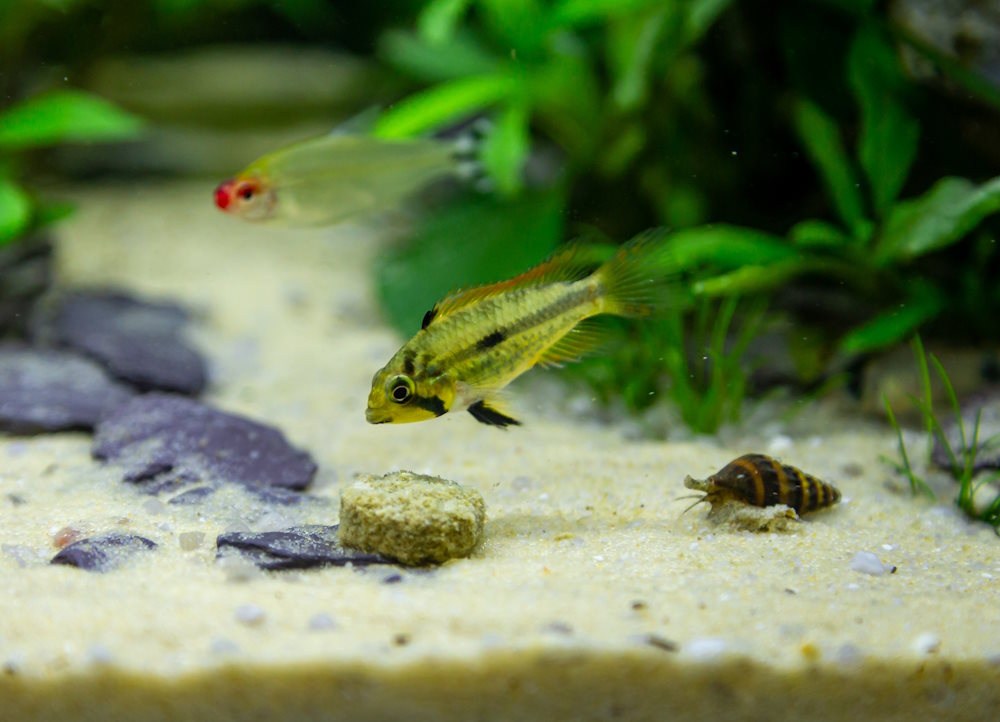Care Guide for Assassin Snails — Natural Way to Get Rid of Pest Snails
If you have a freshwater aquarium that is infested with bladder snails, ramshorn snails, or Malaysian trumpet snails (MTS), it may seem impossible to get rid of them. It’s hard to root out every single egg or baby snail hiding amongst the plants and substrate, and chemical pesticides can often have a negative impact on the other living creatures in your fish tank. Luckily, there is a little helper you can employ that will happily sniff out any pest snails — the amazing assassin snail. Learn how to care for this industrious critter and even breed them for profit in your own home.
What are Assassin Snails?
Anentome helena or Clea helena is a beautiful freshwater snail with a pointy, spiral shell that reaches up to 1 inch (2.5 cm) long. The shell has a ribbed texture and is easily recognized by the alternating dark brown and yellow stripes that look like a bumblebee pattern. You may see it crawling around with a prominently extended siphon tube, which is used to suck in water for passing it across the gills and detecting food. Like the Malaysian trumpet snail, the assassin snail likes to bury itself in sand or gravel substrate, and it will extend its siphon out of the ground, allowing it to easily breathe in fresh water and smell the surrounding area. As soon as it gets a whiff of food in the vicinity, it will pop out of the ground to go hunting.

The assassin snail usually crawls around with its siphon extended to help detect food.
How to Set Up an Aquarium for Assassin Snails
This Southeast Asian snail is found in Thailand, Malaysia, and the island of Sumatra in Indonesia. Because of its small size, one snail can easily live in 2 gallons of water or more at temperatures of 70–80°F (21–27°C). Like most snails, it prefers alkaline pH from 7.2–8.0 and moderate to hard GH. If you notice the snail is developing holes and pits in its shell, you may have soft water and need to add crushed coral and mineral supplements to ensure healthy shell growth.
What animals can live with assassin snails? Given its common name, you should remove all snails that you do not wish to get eaten. When kept in groups, assassin snails have the ability to take down larger snails, such as mystery, nerite, and Sulawesi rabbit snails. However, they do not tend to attack their own kind and are safe to keep with peaceful fish, aquarium plants, dwarf shrimp, and other non-snail invertebrates. To avoid having the hunter become the hunted, avoid putting them with snail-eating animals, such as pufferfish and certain types of loaches.

A rummynose tetra, Apistogramma cichlid, and assassin snail are all attracted to the sinking wafer.
What Do Assassin Snails Eat?
As mentioned before, these carnivores love to eat snails of all kinds, and given the opportunity, they will also eat deceased animals, fish eggs, and newborn fry (or wrigglers) that are not freely swimming yet. When you run out of pest snails, you can feed them any kind of high-protein fish food, such as frozen bloodworms, fish flakes, pellets, sinking wafers, and Repashy gel food. To help them grow strong shells that are free of cracks and other imperfections, don’t forget to offer mineral-enriched foods, like nano banquet food blocks and Hikari Fancy Guppy pellets.
How to Breed Assassin Snails
Unlike many pest snail species, assassin snails are not hermaphrodites and cannot reproduce by themselves. They are difficult to sex, so the easiest way is to get a group of six or more to increase your chances of having at least one male and one female for breeding purposes. If you feed them plenty of food, they will naturally begin to reproduce, although at a much slower rate compared to most pest snails. The female will lay a translucent, square-shaped egg capsule with pointy corners that contains a single yellow egg inside. These egg capsules are laid one by one and will stick to various surfaces like rocks, driftwood, or even the substrate. Eventually, if you get a good number of assassin snails, you can sell them to your local fish store or aquarium club. The nice thing about assassin snails is that you can also breed them in the same tank as other species, like guppies and cherry shrimp.

A pair of assassin snail eggs hidden in a crack
While we do not ship live animals, we have a list of preferred online vendors that sell high-quality fish, shrimp, and snails and offer fast shipping right to your front door. To learn more about the wonderful world of aquarium snails, read about the top 7 helpful snails for your next freshwater aquarium.




